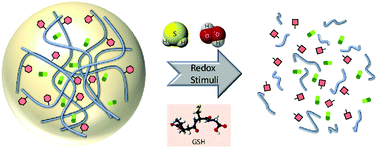Recent progress of redox-responsive polymeric nanomaterials for controlled release
Abstract
Redox-responsive polymeric nanomaterials (PNMs) have been attractive research targets for drug delivery systems because disturbed levels of redox molecules are associated with the progression of various diseases. To enable PNMs to target biorelevant redox molecules, including reactive oxygen species (ROS), glutathione (GSH) and hydrogen sulfide (H2S), appropriate responsive moieties have to be installed within the polymer structure. Upon application of redox stimuli, redox-responsive PNMs undergo structural changes to release encapsulated payloads. Chalcogen ether, thioketal and arylboronic ester have been widely incorporated into the structure of ROS-responsive PNMs. While disulfide is commonly utilized in GSH-responsive PNMs, azide is a newly explored responsive motif targeting H2S selectively. Diselenide, on the other hand, is a group susceptible to both oxidative and reducing conditions and therefore it has been exploited in dual redox-responsive PNMs. Here, we review PNMs, mainly reported in the last four years, that contain these redox-responsive moieties for controlled payload release.

- This article is part of the themed collection: Journal of Materials Chemistry B Recent Review Articles


 Please wait while we load your content...
Please wait while we load your content...
